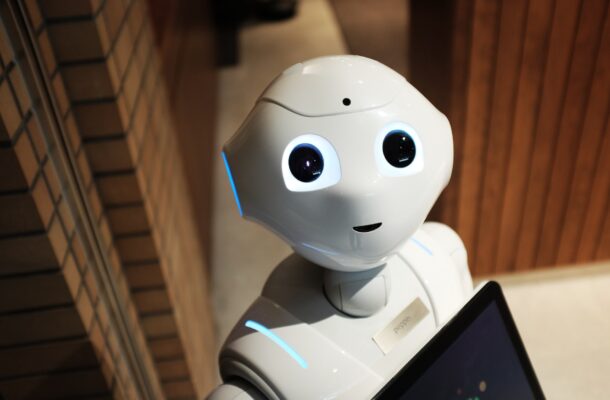The positronic brain

In a new study published in Science Advances, it was claimed that self-organising networks of tiny silver wires appear to learn and remember in much the same way as the thinking hardware in our heads. This aims to replicate the structure and functionality of biological neurons and synapses in non-biological systems. The system uses a network of “nanowires” to mimic the neurons and synapses in the brain. These nanowires are tiny wires about one thousandth the width of a human hair. They are made of a highly conductive metal, such as silver, typically coated in an insulating material like plastic.
Nanowires self-assemble to form a network structure similar to a biological neural network. Like neurons, which have an insulating membrane, each metal nanowire is coated with a thin insulating layer. When we stimulate nanowires with electrical signals, ions migrate across the insulating layer and into a neighbouring nanowire (much like neurotransmitters across synapses). As a result, synapse-like electrical signalling in nanowire networks was observed. This demonstrates that selectively strengthening (and weakening) synaptic pathways in nanowire networks can be achieved.
This is similar to “supervised learning” in the brain. In this process, the output of synapses is compared to a desired result. Then the synapses are strengthened (if their output is close to the desired result) or pruned (if their output is not close to the desired result). By “rewarding” or “punishing” the network the learning can be reinforced as occurs in the human brain. When a number of stimuli were presented, the memory appeared to hold around seven activated synapses, or the same number as the average human can readily handle.
Nanowire networks are different from the artificial neural networks used in AI. Still, they may lead to so-called “synthetic intelligence”. In 2004, researchers built a single electronic device that is capable of copying the functions of neuron cells in a brain. 20 of them were then connected together to perform a complicated calculation. This work shows that it is scientifically possible to make an advanced computer that does not rely on transistors to calculate and that uses much less electrical power than today’s data centres.
As AI becomes more closely associated with the human brain it is necessary to explore our thought capabilities more closely. We live in a vibrant, complex and transient world where we constantly face a barrage of information competing for our attention. For example, our eyes take in over one megabyte of data every second. That’s equivalent to reading 500 pages of information or an entire encyclopedia every minute.
Just one whiff of a familiar smell can trigger a memory from childhood in less than a millisecond, and our skin contains up to 4 million receptors that provide us with important information about temperature, pressure, texture, and pain. And if that wasn’t enough data to process, we make thousands of decisions every single day. Many of them are unconscious and/or minor, such as putting seasoning on your food, picking a pair of shoes to wear, choosing which street to walk down, and so on. Because we simply cannot process all the incoming data, our brains create habits – automations of the behaviours and actions we often repeat.
Intention and Habit
There are two forces that govern our behaviour: intention and habit. In simple terms, our brain has dual processing systems, sort of like a computer with two processors.
Performing a behaviour for the first time requires intention, attention and planning – even if plans are made only moments before the action is performed. This happens in our prefrontal cortex. More than any other part of the brain, the prefrontal cortex is responsible for making deliberate and logical decisions. It’s the key to reasoning, problem-solving, comprehension, impulse control and perseverance. It affects behaviour via goal-driven decisions.
For example, you use your “reflective” system (intention) to make yourself go to bed on time because sleep is important, or to move your body because you’ll feel great afterwards. When you are learning a new skill or acquiring new knowledge, you will draw heavily on the reflective brain system to form new memory connections in the brain. This system requires mental energy and effort.
On the other hand, your “impulsive” (habit) system is in your brain’s basal ganglia, which plays a key role in the development of emotions, memories, and pattern recognition. It’s impetuous, spontaneous, and pleasure seeking. For example, your impulsive system might influence you to pick up greasy takeaway on the way home from a hard day at work, even though there’s a home-cooked meal waiting for you. Or it might prompt you to spontaneously buy a new, expensive television.
This system requires no energy or cognitive effort as it operates reflexively, subconsciously and automatically. When we repeat a behaviour in a consistent context, our brain recognises the patterns and moves the control of that behaviour from intention to habit. A habit occurs when your impulse towards doing something is automatically initiated because you encounter a setting in which you’ve done the same thing in the past. For example, getting your favourite takeaway because you walk past the food joint on the way home from work every night – and it’s delicious every time, giving you a pleasurable reward.
Because habits sit in the impulsive part of our brain, they don’t require much cognitive input or mental energy to be performed.
Force of Habit
In other words, habits are the mind’s shortcuts, allowing us to successfully engage in our daily life while reserving our reasoning and executive functioning capacities for other thoughts and actions.
Your brain remembers how to drive a car because it’s something you’ve done many times before. Forming habits is, therefore, a natural process that contributes to energy preservation. That way, your brain doesn’t have to consciously think about your every move and is free to consider other things – like what to make for dinner, or where to go on your next holiday.
During the early stages of habit formation, the decision parts of your brain (pre-frontal cortices) are activated, and the action is very deliberate (instead of hitting snooze you make the choice to get out of bed). When a new routine is initiated, brain circuits – also called neural networks – are activated.
The more often you repeat the new action, the stronger and more efficient these neural networks become. This reorganising and strengthening of connections between neurons is called neuroplasticity, and in the case of building habits – long-term potentiation.
Each time you perform the new action while trying to form a habit, you need smaller cues or triggers to activate the same network of brain cells. As habits strengthen, the decision parts of the brain no longer need to kick in to initiate the action. The habit is now activated in memory and considered automatic: the neural circuits can perform the habit without conscious thought.
In other words, you don’t need to choose to perform the action any more. A seminal study published in the European Journal of Social Psychology is often cited as showing habits take anywhere from 18 to 254 days to form, with an average of about 66 days.
Learning in the brain is thought to occur via three main mechanisms: supervised learning, typically linked to the cerebellum; reinforcement learning, typically linked to the basal ganglia; and unsupervised learning, typically linked to the cerebral cortex. These are all specifically related to animal brains which have developed over millions of years. Programming AI’s to react in this way is quite possible but not practicable if the target is merely to amalgamate data in order to respond to specific questions.
The GPT4 system uses about the same amount of energy as a small Australian town, yet we tend to use it for rather mundane purposes. Nano-wires use a fraction of that amount. If we are going to use the tremendous potential here, maybe we should think very carefully about our access to it. Our own brains have tremendous abilities, many of which have yet to be tapped.
J’ai commencé par prendre Kamagra 100mg de kamagra gelée orale il y a deux semaines et j’ai pris de meilleures photos de mes érections et la qualité était incroyable. Je n’ai eu des érections que trois fois par jour. Je me sentais très bien tout au long de la journée. Mon médecin m’a expliqué le Kamagra Gelée Orale et c’est pourquoi je l’ai utilisé. Il existe d’autres médicaments similaires mais je préfère Kamagra Gelée Orale.

Alan Stevenson spent four years in the Royal Australian Navy; four years at a seminary in Brisbane and the rest of his life in computers as an operator, programmer and systems analyst. His interests include popular science, travel, philosophy and writing for Open Forum.














